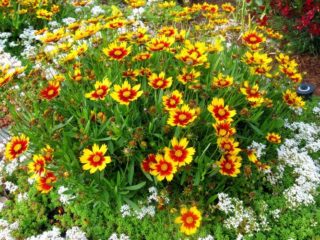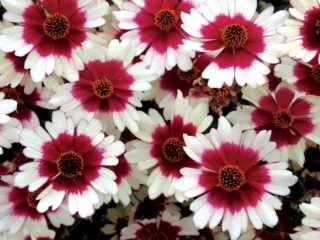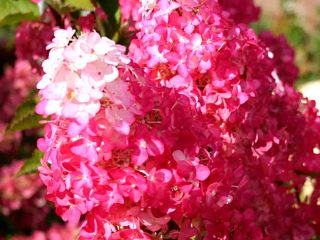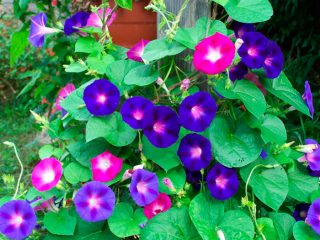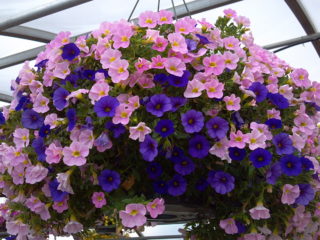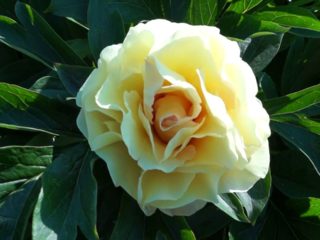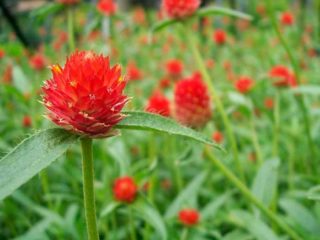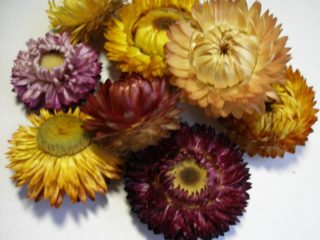Content
Coreopsis whorled relatively recently gained popularity. Gardeners speak of it as a grateful plant that does not require special care, but effectively decorates any area. The variety of varieties allows you to choose the most suitable crop for the garden.
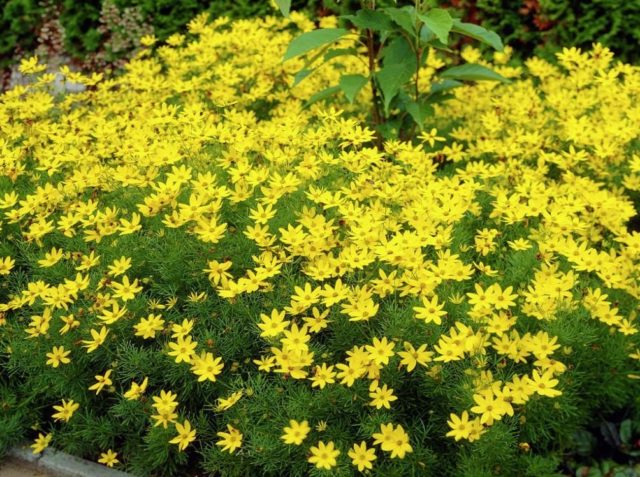
Popularly, whorled coreopsis is called “Parisian beauty”, “sun in the garden” or “Lenok”
History of the appearance of Coreopsis Verticillata
The name Coreopsis whorled comes from Ancient Greece. It consists of the words koris - bug, and opsis - species. The reason for this strange name was the appearance of the seeds, which reminded the Greeks of a bug.
But the homeland of whorled coreopsis is the east of North America, where it grows in dry light forests and open pine forests. It has been in culture since 1750. Currently, coreopsis whorled has spread to some regions of Africa and South America. It is also found in Russia.
Description and characteristics
Coreopsis whorled is a herbaceous perennial of the Asteraceae family. These are unpretentious and frost-resistant plants that can often be found along highways. The bush is 50-90 cm high and up to 60 cm in diameter. The stems are rigid, branched, and erect. They have densely arranged needle-like light green and dark green leaves in opposite order. The near-stem foliage is palmate or pinnately divided, the basal leaves are entire.
Flowers with a diameter of about 3 cm, rich yellow, pink, purple, red. They resemble little stars or daisies. Towards the middle the color darkens. Flowering is abundant and lasts from the 2nd half of June until September. In place of faded inflorescences, seed pods are formed. The seeds are small and round in shape.
Varieties of Coreopsis whorled perennial
Coreopsis whorled has about 100 varieties, of which about 30 are actively used by gardeners. Among them there are both annual and perennial plants. The latter are in higher demand.
Coreopsis whorled Zagreb
The height of the Zagreb variety reaches only 30 cm. This low-growing plant with golden flowers loves light, but can develop well in slight shade. It is characterized by resistance to frost and can withstand winter without additional shelter.
It is not too picky about the soil, but will respond to fertilizing with an abundance of flowers. It is important to maintain a balance in fertilizing and watering. If the groundwater is high, the roots may rot. You should also not over-hydrate the plant in winter.
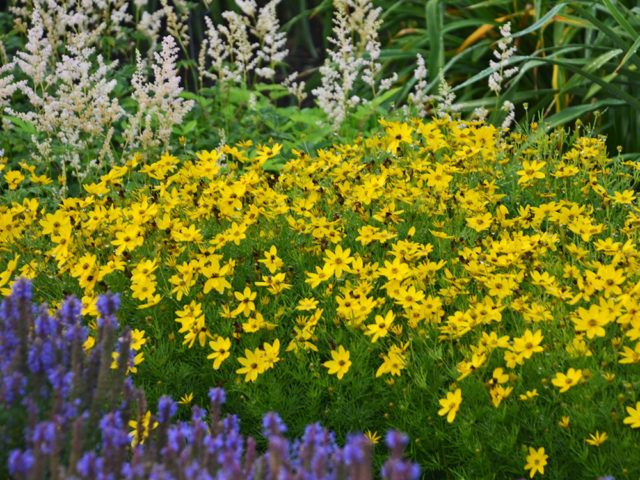
In 2001, the Coreopsis whorled variety Zagreb received the AGM Award from the Royal Horticultural Society of Great Britain
Coreopsis whorled Ruby Red
Ruby Red is distinguished by its rich red color. The height of the bush is about 50 cm. The leaves are needle-like, very narrow, light green. The flowers are about 5 cm in diameter, the leaves have a “ragged” effect at the ends. In the photo above you can see that the Ruby Red whorled coreopsis bush is very dense, with a uniform red-green structure.
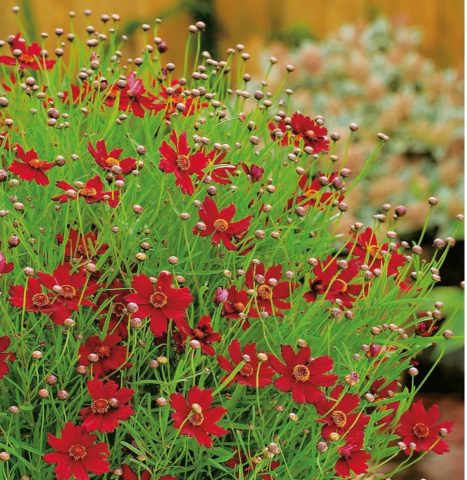
The winter hardiness zone of the Ruby Red variety is 5, the plant easily tolerates the cold of central Russia
Coreopsis whorled Moonbeam
Coreopsis whorled Moonbeam is a low-growing variety, reaching a height of 30 cm. The flowers are pale milky yellow, 3-5 cm in diameter. The petals are long, slightly elongated, and regular in shape. The core is a darker yellow color. The leaves are needle-shaped, dark green. Frost resistance zone – 3.

Moonbeam became especially popular in 1992 after it was named Perennial of the Year by the Perennial Plant Association.
Delicate light yellow flowers make the bush openwork. The Moonbeam variety is perfect for planting in tandem with heliopsis, delphinium, salvia, and eryngium.
Coreopsis whorled Grandiflora
The Grandiflora variety is distinguished by its tall shoots, reaching 70 cm. They bear bright yellow flowers with a red splash at the base. The diameter of the bud is about 6 cm. The petals have a serrated edge. The leaves are not as tall as the shoots; they are half as tall. This makes the bush not as dense as other varieties, but no less beautiful.
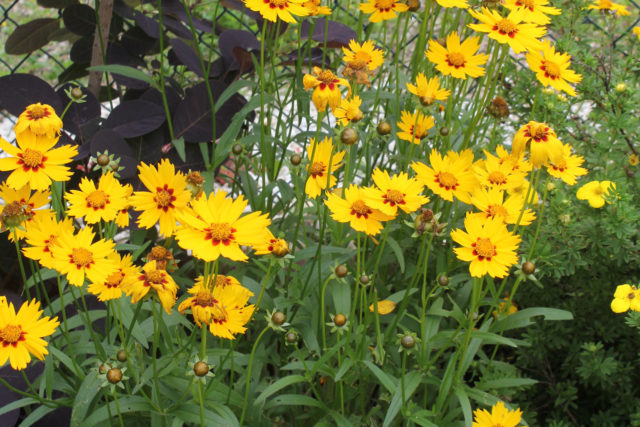
In 2003, the Coreopsis whorled variety Grandiflora was also awarded the AGM Award of the Royal Horticultural Society of Great Britain
Planting and caring for Coreopsis whorled
Planting whorled coreopsis is possible either by seedling method or directly in open ground. The first method will give you the opportunity to see flowering in the same year.
Planting of seedlings occurs in March-April as follows:
- Sow the seeds in a wide, shallow container with fertile soil. Sprinkle a mixture of soil and sand on top. Water. Cover with film or a transparent bag to create a greenhouse effect.
- Place the container with the seedlings in a warm, bright place. A window sill on the south side works well. Moisten the soil with a spray bottle every few days.
- After the first shoots appear, the film can be removed.
- 2 weeks after emergence, when the plants reach 10-12 cm, the seedlings can be planted in separate containers. Peat pots are best suited. Seedlings require periodic watering and a lot of light. The plants will remain in this position until the beginning of June, then they need to be transplanted into open ground.
Open sunny areas or light partial shade are suitable for whorled coreopsis. The soil should be neutral, moist and nutritious, well drained.
Landing algorithm:
- Moisten the peat pots with seedlings well so that the soil with the plant can be easily removed.
- Prepare a hole: dig a hole 50 cm deep. If the soil is poor, mix the excavated soil with compost and peat in equal proportions. Pour drainage into the bottom of the hole. Place some prepared soil on it.
- The distance between the holes should be at least 30 cm.
- Remove the plant from the pot along with the soil, carefully place it in the hole, and sprinkle with the remaining fertilized soil. Lightly compact the soil and water the seedling.
- To retain moisture in the ground and to prevent the appearance of weeds, the soil around the plant must be mulched. Rotted sawdust is ideal, but you can use dry grass, hay, straw, and bark.
Caring for whorled coreopsis is quite simple, including watering, fertilizing, loosening the soil and protecting against diseases. In hot weather, the plant should be watered 1-2 times a week, in warm weather even less often. Before flowering, coreopsis should be fertilized with a complex mineral composition. Poor soil requires additional fertilizing before the onset of cold weather. In order for the flowering to be abundant and the bush to be lush, the soil must be periodically loosened. This will get rid of weeds and saturate the soil with oxygen. In addition, for stable flowering, faded buds must be cut off immediately. To prevent the appearance of pests and diseases, plants should be treated with insecticides before flowering.
Before winter, the entire bush is cut down to 10-15 cm in height. In warm regions, coreopsis overwinters without additional shelter; in temperate zones, the bush can be insulated with spruce branches or tops. For the northern regions, so that the plant does not die, it is completely dug up and transplanted into a special container.
Coreopsis whorled in landscape design
Not every gardener has the opportunity to have large spaces. To decorate a small area, coreopsis whorled can be used as a bright background for lower plants.Group plantings look impressive both on a flat lawn and in pairs with other bushes, such as spirea and mock orange.

One of the main advantages of whorled coreopsis is the versatility of cultivation: it looks equally good as small flowers, a single bush or an entire alley
The color differences of Coreopsis whorled varieties allow the crop to be widely combined with other partners. Low-growing varieties will look appropriate along the border in the foreground. In tandem you can choose speedwells, irises, geraniums and ameria. The external resemblance to chamomile also gives a lot of options. Alternating both crops, grouping with bushes or replacing one flower with another after the end of the planting period in one place - everyone chooses for themselves.
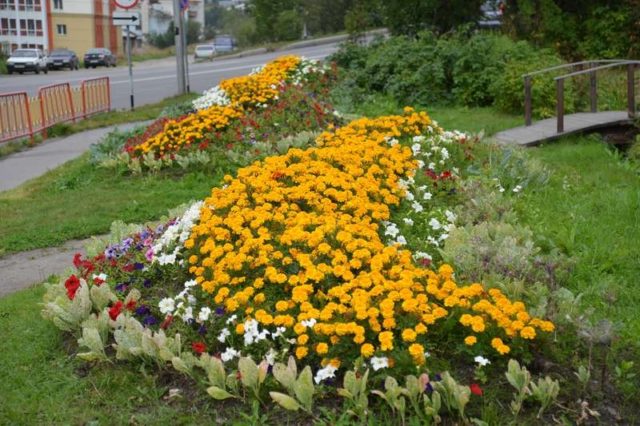
The use of whorled coreopsis is popular for decorating city roads and in flower arrangements on slopes
In order for whorled coreopsis to please with an abundance of flowers, it should be planted on the south side of buildings, fences, and tree and shrub plantings. This crop, planted in outdoor vases and balcony containers, will look like an independent composition. Long-term flowering will make whorled coreopsis an important figure on the site.

The photo shows an example of a balanced color scheme: bright yellow coreopsis bushes are combined with calm greenery
Conclusion
Coreopsis whorled belongs to those types of flowers that were discovered a long time ago, but for unknown reasons began to gain popularity only recently. In the frantic pace of life in the 21st century, those plants that do not require time and give spectacular results have become valued.
